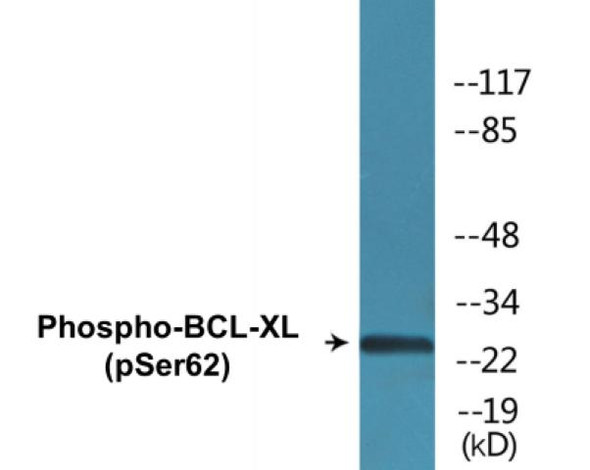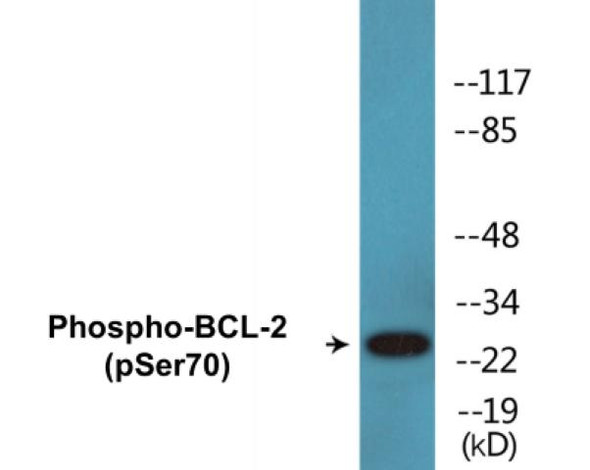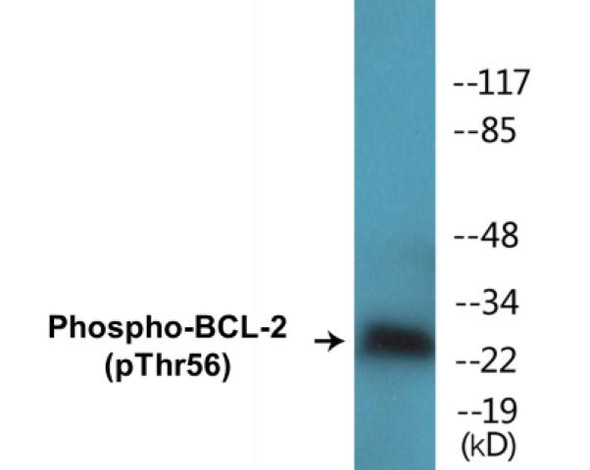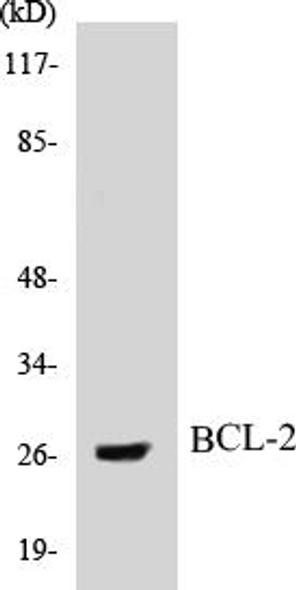Description
| Product Name: | BCL-XL (Phospho-Thr47) Colorimetric Cell-Based ELISA |
| Product Code: | CBCAB01367 |
| ELISA Type: | Cell-Based |
| Target: | BCL-XL (Phospho-Thr47) |
| Reactivity: | Human, Mouse, Rat |
| Dynamic Range: | > 5000 Cells |
| Detection Method: | Colorimetric 450 nm |
| Format: | 2 x 96-Well Microplates |
The BCL-XL (Phospho-Thr47) Colorimetric Cell-Based ELISA Kit is a convenient, lysate-free, high throughput and sensitive assay kit that can detect BCL-XL protein phosphorylation and expression profile in cells. The kit can be used for measuring the relative amounts of phosphorylated BCL-XL in cultured cells as well as screening for the effects that various treatments, inhibitors (ie. siRNA or chemicals), or activators have on BCL-XL phosphorylation.
Qualitative determination of BCL-XL (Phospho-Thr47) concentration is achieved by an indirect ELISA format. In essence, BCL-XL (Phospho-Thr47) is captured by BCL-XL (Phospho-Thr47)-specific primary (1ø) antibodies while the HRP-conjugated secondary (2ø) antibodies bind the Fc region of the 1ø antibody. Through this binding, the HRP enzyme conjugated to the 2ø antibody can catalyze a colorimetric reaction upon substrate addition. Due to the qualitative nature of the Cell-Based ELISA, multiple normalization methods are needed:
| 1. | A monoclonal antibody specific for human GAPDH is included to serve as an internal positive control in normalizing the target absorbance values. |
| 2. | Following the colorimetric measurement of HRP activity via substrate addition, the Crystal Violet whole-cell staining method may be used to determine cell density. After staining, the results can be analysed by normalizing the absorbance values to cell amounts, by which the plating difference can be adjusted. |
| Database Information: | Gene ID: 598, UniProt ID: Q07817, OMIM: 600039, Unigene: Hs.516966 |
| Gene Symbol: | BCL2L1 |
| Sub Type: | Phospho |
| UniProt Protein Function: | Bcl-xL: an antiapoptotic member of the Bcl-2 family. Located at the outer mitochondrial membrane and regulates outer mitochondrial membrane channel (VDAC) opening. VDAC regulates mitochondrial membrane potential, and thus controls the production of reactive oxygen species and release of cytochrome C by mitochondria, both of which are potent inducers of cell apoptosis. Two alternatively spliced isoforms have been reported. |
| UniProt Protein Details: | Protein type:Mitochondrial; Autophagy; Apoptosis; Membrane protein, integral Chromosomal Location of Human Ortholog: 20q11.21 Cellular Component: cell junction; centrosome; cytoplasm; cytosol; integral to membrane; mitochondrial inner membrane; mitochondrial matrix; mitochondrial outer membrane; mitochondrion; nuclear membrane; synaptic vesicle membrane Molecular Function:BH3 domain binding; identical protein binding; protein binding; protein heterodimerization activity; protein homodimerization activity; protein kinase binding Biological Process: apoptotic mitochondrial changes; cell proliferation; cellular process regulating host cell cycle in response to virus; cytokinesis; DNA damage response, signal transduction resulting in induction of apoptosis; endocytosis; fertilization; germ cell development; growth; in utero embryonic development; male gonad development; mitotic cell cycle checkpoint; negative regulation of apoptosis; negative regulation of autophagy; negative regulation of neuron apoptosis; neuron apoptosis; ovarian follicle development; positive regulation of cell proliferation; regulation of mitochondrial membrane permeability; regulation of mitochondrial membrane potential; release of cytochrome c from mitochondria; response to cycloheximide; response to cytokine stimulus; spermatogenesis; suppression by virus of host apoptosis |
| NCBI Summary: | The protein encoded by this gene belongs to the BCL-2 protein family. BCL-2 family members form hetero- or homodimers and act as anti- or pro-apoptotic regulators that are involved in a wide variety of cellular activities. The proteins encoded by this gene are located at the outer mitochondrial membrane, and have been shown to regulate outer mitochondrial membrane channel (VDAC) opening. VDAC regulates mitochondrial membrane potential, and thus controls the production of reactive oxygen species and release of cytochrome C by mitochondria, both of which are the potent inducers of cell apoptosis. Alternative splicing results in multiple transcript variants encoding two different isoforms. The longer isoform acts as an apoptotic inhibitor and the shorter isoform acts as an apoptotic activator. [provided by RefSeq, Dec 2015] |
| UniProt Code: | Q07817 |
| NCBI GenInfo Identifier: | 728955 |
| NCBI Gene ID: | 598 |
| NCBI Accession: | Q07817.1 |
| UniProt Secondary Accession: | Q07817,Q5CZ89, Q5TE65, Q92976, E1P5L6, |
| UniProt Related Accession: | Q07817 |
| Molecular Weight: | 25,290 Da |
| NCBI Full Name: | Bcl-2-like protein 1 |
| NCBI Synonym Full Names: | BCL2 like 1 |
| NCBI Official Symbol: | BCL2L1 |
| NCBI Official Synonym Symbols: | BCLX; BCL2L; Bcl-X; PPP1R52; BCL-XL/S |
| NCBI Protein Information: | bcl-2-like protein 1 |
| UniProt Protein Name: | Bcl-2-like protein 1 |
| UniProt Synonym Protein Names: | Apoptosis regulator Bcl-X |
| UniProt Gene Name: | BCL2L1 |
| UniProt Entry Name: | B2CL1_HUMAN |
| Component | Quantity |
| 96-Well Cell Culture Clear-Bottom Microplate | 2 plates |
| 10X TBS | 24 mL |
| Quenching Buffer | 24 mL |
| Blocking Buffer | 50 mL |
| 15X Wash Buffer | 50 mL |
| Primary Antibody Diluent | 12 mL |
| 100x Anti-Phospho Target Antibody | 60 µL |
| 100x Anti-Target Antibody | 60 µL |
| Anti-GAPDH Antibody | 60 µL |
| HRP-Conjugated Anti-Rabbit IgG Antibody | 12 mL |
| HRP-Conjugated Anti-Mouse IgG Antibody | 12 mL |
| SDS Solution | 12 mL |
| Stop Solution | 24 mL |
| Ready-to-Use Substrate | 12 mL |
| Crystal Violet Solution | 12 mL |
| Adhesive Plate Seals | 2 seals |
The following materials and/or equipment are NOT provided in this kit but are necessary to successfully conduct the experiment:
- Microplate reader able to measure absorbance at 450 nm and/or 595 nm for Crystal Violet Cell Staining (Optional)
- Micropipettes with capability of measuring volumes ranging from 1 µL to 1 ml
- 37% formaldehyde (Sigma Cat# F-8775) or formaldehyde from other sources
- Squirt bottle, manifold dispenser, multichannel pipette reservoir or automated microplate washer
- Graph paper or computer software capable of generating or displaying logarithmic functions
- Absorbent papers or vacuum aspirator
- Test tubes or microfuge tubes capable of storing ≥1 ml
- Poly-L-Lysine (Sigma Cat# P4832 for suspension cells)
- Orbital shaker (optional)
- Deionized or sterile water
*Note: Protocols are specific to each batch/lot. For the correct instructions please follow the protocol included in your kit.
| Step | Procedure |
| 1. | Seed 200 µL of 20,000 adherent cells in culture medium in each well of a 96-well plate. The plates included in the kit are sterile and treated for cell culture. For suspension cells and loosely attached cells, coat the plates with 100 µL of 10 µg/ml Poly-L-Lysine (not included) to each well of a 96-well plate for 30 minutes at 37 °C prior to adding cells. |
| 2. | Incubate the cells for overnight at 37 °C, 5% CO2. |
| 3. | Treat the cells as desired. |
| 4. | Remove the cell culture medium and rinse with 200 µL of 1x TBS, twice. |
| 5. | Fix the cells by incubating with 100 µL of Fixing Solution for 20 minutes at room temperature. The 4% formaldehyde is used for adherent cells and 8% formaldehyde is used for suspension cells and loosely attached cells. |
| 6. | Remove the Fixing Solution and wash the plate 3 times with 200 µL 1x Wash Buffer for five minutes each time with gentle shaking on the orbital shaker. The plate can be stored at 4 °C for a week. |
| 7. | Add 100 µL of Quenching Buffer and incubate for 20 minutes at room temperature. |
| 8. | Wash the plate 3 times with 1x Wash Buffer for 5 minutes each time. |
| 9. | Add 200 µL of Blocking Buffer and incubate for 1 hour at room temperature. |
| 10. | Wash 3 times with 200 µL of 1x Wash Buffer for 5 minutes each time. |
| 11. | Add 50 µL of 1x primary antibodies Anti-BCL-XL (Phospho-Thr47) Antibody, Anti-BCL-XL Antibody and/or Anti-GAPDH Antibody) to the corresponding wells, cover with Parafilm and incubate for 16 hours (overnight) at 4 °C. If the target expression is known to be high, incubate for 2 hours at room temperature. |
| 12. | Wash 3 times with 200 µL of 1x Wash Buffer for 5 minutes each time. |
| 13. | Add 50 µL of 1x secondary antibodies (HRP-Conjugated AntiRabbit IgG Antibody or HRP-Conjugated Anti-Mouse IgG Antibody) to corresponding wells and incubate for 1.5 hours at room temperature. |
| 14. | Wash 3 times with 200 µL of 1x Wash Buffer for 5 minutes each time. |
| 15. | Add 50 µL of Ready-to-Use Substrate to each well and incubate for 30 minutes at room temperature in the dark. |
| 16. | Add 50 µL of Stop Solution to each well and read OD at 450 nm immediately using the microplate reader. |
(Additional Crystal Violet staining may be performed if desired – details of this may be found in the kit technical manual.)






